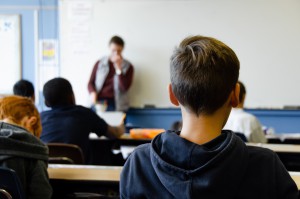By Catia Malaquias, PhD Student with Katie Ellis, Director Centre for Culture and Technology (CCAT), Curtin University
The Australian Government is saying that “students can now go back to school – but when and how depends on what your particular State government tells you”.
But for students with health conditions, some State governments are telling parents to seek the advice of their family doctor. They are not taking any “responsibility” for parents’ decisions as to when it may be “safe” to return their child to school.
This is particularly the situation for many students with disability, who are recognised as being at much greater risk from the COVID-19 pandemic due to a higher incidence of health conditions, including compromised immunity.
We can anticipate that family doctors, in the face of a new and potentially deadly virus and little research evidence, will be conservative: “If your child goes back to school, they are at increased risk of infection and, if infected, they will have a higher risk of complications etc.”
So what are those parents to do?
We expect that most will tread carefully – and many will hold back their children – not only their child with predisposition to respiratory infections, etc – but also their non-disabled siblings too, as potential transmitters within the family unit.
Families with children with respiratory and immune system sensitivities were the first to withdraw their children from school – weeks before schools generally encouraged parents to do so – and they will likely be the last to return their children, together with their non-disabled or health-compromised siblings, to school. What is less clear is when.
Many children with disability will be particularly affected by schooling disruption and disconnection. For example, some will have lost school routines that provided them with predictability and reassurance they need to learn, others will be struggling to access and understand content that is no longer delivered directly by teachers and in person but is delivered online in ways that are not accessible for them – while others will be experiencing isolation without the benefit of peer relationships, including peer role models and tutors.
While many teachers across the country are working hard to mitigate these impacts on their students with disability – providing differentiated class materials for home learning and striving to maintain connection with their students and in turn their student’s connection with their class peers – in too many cases this is far from the reality.
Many parents of students with disability are reporting that their children are no longer receiving “reasonable adjustments” that were previously provided and which continue to be required under the Disability Discrimination Act 1992. Others are saying their children are being denied access to the Australian curriculum and being provided with alternative poor quality content focusing on “life skills” such as “removing weeds in the garden” and taking photos of objects around the house.
As Term 2 starts around the country, many teachers are also concerned by what they are being told by their education departments. Some States are implementing a “soft opening” of schools with parents initially having the choice between in class learning or home learning – while teachers are being assured that they will not be expected “to deliver learning to their students at school and at home simultaneously”. It is unclear how this will be implemented but already there are reports of “at home” students being re-allocated to different teachers or to different year groups – effectively being disconnected from their usual class peers and their usual class teachers.
This is an exercise of convenience – instead of staying with their class as a learning cohort and receiving reasonable adjustment to access the class lesson, some students with disability are simply being told to access a class at “their level” – for example, a year 5 student being disconnected from their class, their teachers and peers and attached to an on-line year 2 class. How is this different to enrolling a year 5 student in a year 2 class? It isn’t – it is a discriminatory practice that denies any measure of inclusive education to students who most require connection with their class curriculum, teacher and peers.
In Italy where schools have been closed for an extended period, teachers are being urged to reach out – online and by telephone – to students with disability who are suffering severely from disconnection and isolation while they have been learning at home.
In some Australian States, education departments are reported to have “outsourced” to special schools responsibility for lesson content to be delivered to students with disability across the public education system and to have resurrected widely recognised inferior “alternative curriculum” materials, previously discarded in favour of equitable access to the Australian curriculum.
The “special education” sector is experienced, trained and practised in dealing with students in segregated settings. They are not practised in delivering the regular classroom curriculum in an inclusive manner – curriculum aligned, age appropriate content that has been differentiated for the capacity and needs of the child, whilst socially connected to their same-age non-disabled peers.
For many families that have worked hard to support their children to access inclusive education in a regular classroom with similar aged peers at their local school, this is rightly unacceptable.
While the Australian government’s seven “COVID-19 National Principles for School Education” say that every child is equally entitled to an education in a COVID-19 world, the reality is that the academic education and social development of children with disability and virus-sensitive health conditions will be the most compromised – as to duration of disconnection and quality of content and delivery of lessons.
Every child has an equal human right to receive an inclusive education, notwithstanding the broader circumstances of their community.
However, in the current climate, students with disability are at the greatest risk of being adversely affected by the ongoing COVID-19 crisis and need the most support from their schools to maintain their education progress, academically and socially until it is safe for them to return to school. Disconnecting them from their class teacher, class lesson and peer cohort is more than an exercise in managing “inconvenience” – it is unfair and unconscionable.
Students with disability were the “last to arrive” in the general education system – and again – their needs in this pandemic seem to be the last considered – even though they have the most to lose.
Equality in education for students at higher risk of COVID-19 complications necessarily means a more sustained and dedicated remote learning program, differentiated as appropriate for each child, with an equally sustained and dedicated social connection program.
Teachers are being asked for more than most sectors of society, but achieving the heavy demands placed upon them cannot be at the expense of some students over others and the deepening of existing access and attainment gaps and inequities in our education system – that is sacrificing the needs that can least afford to be sacrificed.
Where students with disability need to learn from home during the COVID-19 crisis it is critical to ensure that their fundamental human right to education is met through lesson content differentiated (as appropriate) and delivered by their class teachers in a manner that is sensitive to the need for the student to remain academically and socially connected to their usual classrooms – otherwise many of the hard-earned benefits of prior years of “inclusion” will also be wiped out by the pandemic.
________________________________________________________________________________________________________________________________

